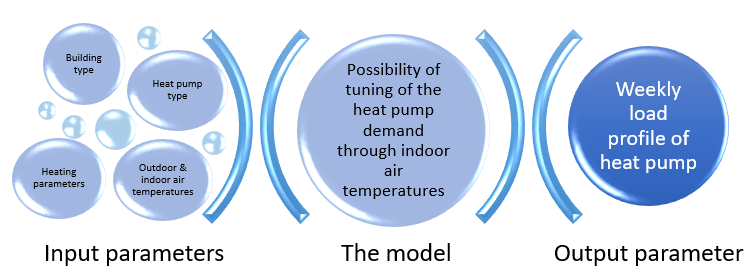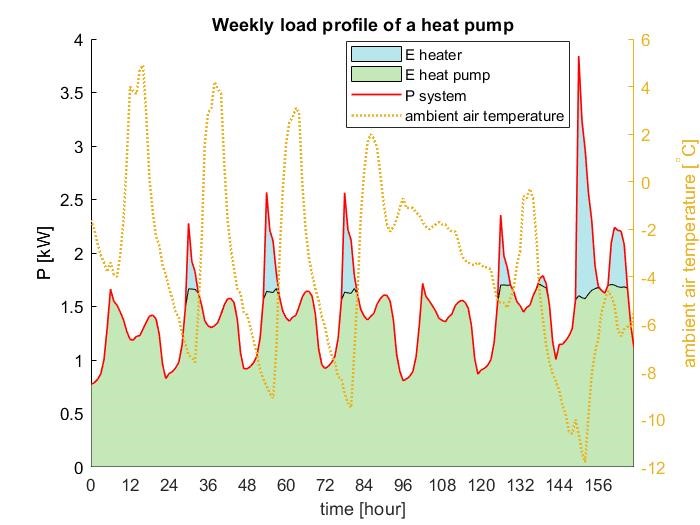Valerija Jordan, Boštjan Blažič
Since the adoption of the Paris Climate Agreement in 2015, almost the entire world community aims for reduction in greenhouse gas emissions and use of renewable energy sources in the response to the threat of the climate change [1], [2]. In this context, one of the main challenges for policy makers, energy system planners and grid operators is the de-carbonization of the energy sector [3]. The flexibility of power consumption of electric heat pumps, which can be regarded as a substitution for fossil-fueled alternatives becomes increasingly important to the electricity system [4]. Moreover, it may not only help to decarbonize the heat sector but can also contribute to the power system integration of variable renewables [1]. The paper presents a simplified model of flexible heat pump load profiles based on the thermal demand load curves, the ambient air temperature series and the desired indoor air temperature of buildings.
The model
In order to model a weekly demand series of a heat pump, some basic information about the heat pump and the building itself are needed. There are three main types of the heat pumps, namely air source heat pump (ASHP), ground source heat pump (GSHP) and water source heat pump (WSHP). As the names tell, different technologies make use of thermal energy of different heat sources, such as air, water or soil. The absorbed heat is then transferred to the heat sink for example radiator, floor heating or water heating.
Since it is difficult to gather all the required parameters of the building to model its thermal properties, three generalized types of buildings are considered in the model. First type is a single-family house, second type is a multi-family house and the third one is a commercial building. For all these types of buildings, the model computes heat demand using standard load profiles that depend on outdoor air temperature.
When the heat demand of the building is known, the coefficient of performance (COP) is defined. The COP is the ratio between the heat output of the heat pump and its electrical energy input [5]. For simplicity, the model takes COP approximation that is calculated through quadratic regression applied to manufacturer data on the COP under different temperature conditions for each of the heat pump types in the article [4]. When the heat demand of the building and the COP of the heat pump are calculated, an electric demand of the heat pump can easily be computed.
Usually, heat pumps have built-in immersion heaters to cover peak loads in cold winter days when the heat pump itself can no longer supply enough heat to the building. In order to compute the load profile of a heat pump together with the heater, the model includes electric demand of the immersion heater as well.
Since the building can be regarded as a thermal storage device, the flexibility of heat pump load profile is attained by varying desired indoor temperatures of the building. In general, dropping the indoor temperature for 1 K means saving about 5 % of the energy.
As shown on Figure 1, the model takes multiple input parameters described above. These are the building type, the heat pump type and capacity, heating parameters such as heat sink and an average daily heat demand and outdoor and indoor air temperatures. Result or the output parameter of the model is a weekly load profile of the heat pump. An example of such profile can be observed on Figure 2. The yellow dotted line on the figure represents ambient air temperatures of one week in the wintertime. The electric power of the heat pump, which greatly depends on the ambient air temperature, is represented by the red line. The area below the red line is the electric energy of the system (heat pump with built-in electric heater). In fact, the area is a sum of the electric energy of the heat pump itself – the green area, and the electric energy of the electric heater – the blue area.

Figure 1. Graphical presentation of the model

Figure 2. Weekly load profile of the heat pump
Conclusion
Increasing percentage of variable renewables in the electricity system is now asking for more flexible solutions, including demand side management. Heat pumps can be a part of the answer. The article presented simplified model of heat pump weekly load profiles and showed that varying desired indoor temperatures enables the flexibility of heat pump load profiles.
References
[1] A. Bloess, W.-P. Schill, and A. Zerrahn, “Power-to-heat for renewable energy integration: A review of technologies, modeling approaches, and flexibility potentials,” Appl. Energy, vol. 212, pp. 1611–1626, Feb. 2018, doi: 10.1016/j.apenergy.2017.12.073.
[2] J. Conrad and S. Greif, “Modelling Load Profiles of Heat Pumps,” Energies, vol. 12, no. 4, p. 766, Jan. 2019, doi: 10.3390/en12040766.
[3] D. Fischer, A. Surmann, and K. B. Lindberg, “Impact of emerging technologies on the electricity load profile of residential areas,” Energy Build., vol. 208, p. 109614, Feb. 2020, doi: 10.1016/j.enbuild.2019.109614.
[4] O. Ruhnau, L. Hirth, and A. Praktiknjo, “Time series of heat demand and heat pump efficiency for energy system modeling,” Sci. Data, vol. 6, no. 1, pp. 1–10, Oct. 2019, doi: 10.1038/s41597-019-0199-y.
[5] I. Dincer and M. A. Rosen, “Chapter 7 - Exergy Analysis of Heat Pump Systems,” in Exergy (Second Edition), I. Dincer and M. A. Rosen, Eds. Elsevier, 2013, pp. 101–113.




